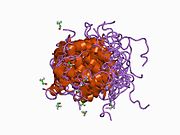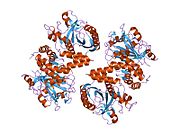- 関
- band 3 erythrocyte membrane protein band 3 anion exchanger 1 Diego blood group, solute carrier family 4, ion exchanger member 1
Wikipedia preview
出典(authority):フリー百科事典『ウィキペディア(Wikipedia)』「2022/10/20 18:16:41」(JST)
wiki en
| SLC4A1 | |||||||||||||||||||||||||||||||||||||||||||||||||||
|---|---|---|---|---|---|---|---|---|---|---|---|---|---|---|---|---|---|---|---|---|---|---|---|---|---|---|---|---|---|---|---|---|---|---|---|---|---|---|---|---|---|---|---|---|---|---|---|---|---|---|---|
 | |||||||||||||||||||||||||||||||||||||||||||||||||||
| |||||||||||||||||||||||||||||||||||||||||||||||||||
| Identifiers | |||||||||||||||||||||||||||||||||||||||||||||||||||
| Aliases | SLC4A1, solute carrier family 4 (anion exchanger), member 1 (Diego blood group), AE1, BND3, CD233, DI, EMPB3, EPB3, FR, RTA1A, SW, WD, WD1, WR, CHC, SAO, SPH4, solute carrier family 4 member 1 (Diego blood group) | ||||||||||||||||||||||||||||||||||||||||||||||||||
| External IDs | OMIM: 109270 MGI: 109393 HomoloGene: 133556 GeneCards: SLC4A1 | ||||||||||||||||||||||||||||||||||||||||||||||||||
| |||||||||||||||||||||||||||||||||||||||||||||||||||
| |||||||||||||||||||||||||||||||||||||||||||||||||||
| |||||||||||||||||||||||||||||||||||||||||||||||||||
| |||||||||||||||||||||||||||||||||||||||||||||||||||
| |||||||||||||||||||||||||||||||||||||||||||||||||||
| Wikidata | |||||||||||||||||||||||||||||||||||||||||||||||||||
| |||||||||||||||||||||||||||||||||||||||||||||||||||
| solute carrier family 4 (anion exchanger), member 1, adapter protein | |||||||
|---|---|---|---|---|---|---|---|
 | |||||||
| Identifiers | |||||||
| Symbol | SLC4A1AP | ||||||
| NCBI gene | 22950 | ||||||
| HGNC | 13813 | ||||||
| OMIM | 602655 | ||||||
| RefSeq | NM_018158 | ||||||
| UniProt | P02730 | ||||||
| Other data | |||||||
| Locus | Chr. 2 p23.3 | ||||||
| |||||||
Band 3 anion transport protein, also known as anion exchanger 1 (AE1) or band 3 or solute carrier family 4 member 1 (SLC4A1), is a protein that is encoded by the SLC4A1 gene in humans.
Band 3 anion transport protein is a phylogenetically-preserved transport protein responsible for mediating the exchange of chloride (Cl−) with bicarbonate (HCO3−) across plasma membranes. Functionally similar members of the AE clade are AE2 and AE3.[5]
Contents
- 1 Function
- 2 Distribution
- 3 Gene products
- 4 Clinical significance
- 5 Interactions
- 6 Discovery
- 7 See also
- 8 References
- 9 Further reading
- 10 External links
Function
Band 3 is present in the basolateral face of the α-intercalated cells of the collecting ducts of the nephron, which are the main acid-secreting cells of the kidney. They generate hydrogen ions and bicarbonate ions from carbon dioxide and water – a reaction catalysed by carbonic anhydrase. The hydrogen ions are pumped into the collecting duct tubule by vacuolar H+ ATPase, the apical proton pump, which thus excretes acid into the urine. kAE1 exchanges bicarbonate for chloride on the basolateral surface, essentially returning bicarbonate to the blood. Here it performs two functions:[citation needed]
- Electroneutral chloride and bicarbonate exchange across the plasma membrane on a one-for-one basis. This is crucial for CO2 uptake by the red blood cell and conversion (by hydration catalysed by carbonic anhydrase) into a proton and a bicarbonate ion. The bicarbonate is then excreted (in exchange for a chloride) from the cell by band 3.
- Physical linkage of the plasma membrane to the underlying membrane skeleton (via binding with ankyrin and protein 4.2). This appears to be to prevent membrane surface loss, rather than having to do with membrane skeleton assembly.
Distribution
It is ubiquitous throughout the vertebrates. In mammals, it is present in two specific sites:[citation needed]
- the erythrocyte (red blood cell) cell membrane and
- the basolateral surface of the alpha-intercalated cell (the acid secreting cell type) in the collecting duct of the kidney.
Gene products
The erythrocyte and kidney forms are different isoforms of the same protein.[6]
The erythrocyte isoform of AE1, known as eAE1, is composed of 911 amino acids. eAE1 is an important structural component of the erythrocyte cell membrane, making up to 25% of the cell membrane surface. Each red cell contains approximately one million copies of eAE1.[citation needed]
The kidney isoform of AE1, known as kAE1 (which is 65 amino acids shorter than erythroid AE1) is found in the basolateral membrane of alpha-intercalated cells in the cortical collecting duct of the kidney.[citation needed]
Clinical significance
Mutations of kidney AE1 cause distal (type 1) renal tubular acidosis, which is an inability to acidify the urine, even if the blood is too acidic. These mutations are disease causing as they cause mistargetting of the mutant band 3 proteins so that they are retained within the cell or occasionally addressed to the wrong (i.e. apical) surface.[citation needed]
Mutations of erythroid AE1 affecting the extracellular domains of the molecule may cause alterations in the individual's blood group, as band 3 determines the Diego antigen system (blood group).[citation needed]
More importantly erythroid AE1 mutations cause 15–25% of cases of hereditary spherocytosis (a disorder associated with progressive red cell membrane loss), and also cause the hereditary conditions of hereditary stomatocytosis[7] and Southeast Asian ovalocytosis.[8]
Interactions
Band 3 has been shown to interact with CA2[9][10][11][12] and CA4.[13]
Discovery
AE1 was discovered following SDS-PAGE (sodium dodecyl sulfate polyacrylamide gel electrophoresis) of erythrocyte cell membrane. The large 'third' band on the electrophoresis gel represented AE1, which was thus initially termed 'Band 3'.[14]
See also
- Cluster of differentiation
- Anion exchanger family
References
- ^ a b c GRCh38: Ensembl release 89: ENSG00000004939 - Ensembl, May 2017
- ^ a b c GRCm38: Ensembl release 89: ENSMUSG00000006574 - Ensembl, May 2017
- ^ "Human PubMed Reference:". National Center for Biotechnology Information, U.S. National Library of Medicine.
- ^ "Mouse PubMed Reference:". National Center for Biotechnology Information, U.S. National Library of Medicine.
- ^ Alper SL (2009). "Molecular physiology and genetics of Na+-independent SLC4 anion exchangers". Journal of Experimental Biology. 212 (11): 1672–1683. doi:10.1242/jeb.029454. PMC 2683012. PMID 19448077.
- ^ Schlüter K, Drenckhahn D (August 1986). "Co-clustering of denatured hemoglobin with band 3: its role in binding of autoantibodies against band 3 to abnormal and aged erythrocytes". Proc. Natl. Acad. Sci. U.S.A. 83 (16): 6137–41. Bibcode:1986PNAS...83.6137S. doi:10.1073/pnas.83.16.6137. PMC 386454. PMID 3461480.
- ^ Bruce LJ, Robinson HC, Guizouarn H, Borgese F, Harrison P, King MJ, Goede JS, Coles SE, Gore DM, Lutz HU, Ficarella R, Layton DM, Iolascon A, Ellory JC, Stewart GW (2005). "Monovalent cation leaks in human red cells caused by single amino-acid substitutions in the transport domain of the band 3 chloride-bicarbonate exchanger, AE1". Nat. Genet. 37 (11): 1258–63. doi:10.1038/ng1656. PMID 16227998. S2CID 23554234.
- ^ Jarolim P, Palek J, Amato D, Hassan K, Sapak P, Nurse GT, Rubin HL, Zhai S, Sahr KE, Liu SC (1991). "Deletion in erythrocyte band 3 gene in malaria-resistant Southeast Asian ovalocytosis". Proc. Natl. Acad. Sci. U.S.A. 88 (24): 11022–6. Bibcode:1991PNAS...8811022J. doi:10.1073/pnas.88.24.11022. PMC 53065. PMID 1722314.
- ^ Sterling D, Reithmeier RA, Casey JR (Dec 2001). "A transport metabolon. Functional interaction of carbonic anhydrase II and chloride/bicarbonate exchangers". J. Biol. Chem. 276 (51): 47886–94. doi:10.1074/jbc.M105959200. PMID 11606574.
- ^ Vince JW, Reithmeier RA (October 1998). "Carbonic anhydrase II binds to the carboxyl terminus of human band 3, the erythrocyte C1-/HCO3- exchanger". J. Biol. Chem. 273 (43): 28430–7. doi:10.1074/jbc.273.43.28430. PMID 9774471.
- ^ Vince JW, Carlsson U, Reithmeier RA (November 2000). "Localization of the Cl-/HCO3- anion exchanger binding site to the amino-terminal region of carbonic anhydrase II". Biochemistry. 39 (44): 13344–9. doi:10.1021/bi0015111. PMID 11063570.
- ^ Vince JW, Reithmeier RA (May 2000). "Identification of the carbonic anhydrase II binding site in the Cl(-)/HCO(3)(-) anion exchanger AE1". Biochemistry. 39 (18): 5527–33. doi:10.1021/bi992564p. PMID 10820026.
- ^ Sterling D, Alvarez BV, Casey JR (July 2002). "The extracellular component of a transport metabolon. Extracellular loop 4 of the human AE1 Cl-/HCO3- exchanger binds carbonic anhydrase IV". J. Biol. Chem. 277 (28): 25239–46. doi:10.1074/jbc.M202562200. PMID 11994299.
- ^ Alberts, Bruce; Johnson, Alexander; Lewis, Julian; Raff, Martin; Roberts, Keith; Walter, Peter. Molecular Biology of the Cell (Fourth ed.). Garland Science. p. 604. ISBN 0815332181.
Further reading
- Tanner MJ (1993). "Molecular and cellular biology of the erythrocyte anion exchanger (AE1)". Semin. Hematol. 30 (1): 34–57. PMID 8434259.
- Chambers EJ, Askin D, Bloomberg GB, Ring SM, Tanner MJ (1998). "Studies on the structure of a transmembrane region and a cytoplasmic loop of the human red cell anion exchanger (band 3, AE1)". Biochem. Soc. Trans. 26 (3): 516–20. doi:10.1042/bst0260516. PMID 9765907.
- Inaba M (2002). "[Band 3: expanding knowledge on its functions]". Seikagaku. 73 (12): 1431–5. PMID 11831035.
- Tanner MJ (2002). "Band 3 anion exchanger and its involvement in erythrocyte and kidney disorders". Curr. Opin. Hematol. 9 (2): 133–9. doi:10.1097/00062752-200203000-00009. PMID 11844997. S2CID 30536102.
- Shayakul C, Alper SL (2004). "Defects in processing and trafficking of the AE1 Cl−/HCO3− exchanger associated with inherited distal renal tubular acidosis". Clin. Exp. Nephrol. 8 (1): 1–11. doi:10.1007/s10157-003-0271-x. PMID 15067510. S2CID 5671983.
External links
- Diego blood group system at BGMUT Blood Group Antigen Gene Mutation Database at NCBI, NIH
- Band+3+Protein at the US National Library of Medicine Medical Subject Headings (MeSH)
- Chloride-Bicarbonate+Antiporters at the US National Library of Medicine Medical Subject Headings (MeSH)
- Human SLC4A1 genome location and SLC4A1 gene details page in the UCSC Genome Browser.
PDB gallery | |
|---|---|
|
Proteins: clusters of differentiation (see also list of human clusters of differentiation) | |
|---|---|
| 1–50 |
|
| 51–100 |
|
| 101–150 |
|
| 151–200 |
|
| 201–250 |
|
| 251–300 |
|
| 301–350 |
|
Membrane transport protein: ion pumps, ATPases / ATP synthase (TC 3A2-3A3) | |||||||
|---|---|---|---|---|---|---|---|
| F-, V-, and A-type ATPase (3.A.2) |
| ||||||
| P-type ATPase (3.A.3) |
| ||||||
see also ATPase disorders | |||||||
Membrane proteins, carrier proteins: membrane transport proteins solute carrier (TC 2A) | |||||||||||||||||||||||||||||||||||||||||||||||||||||||||||||||||||||||||||||||||||||||||||||||||||||||||||||||||||||||||||||||||||||||||
|---|---|---|---|---|---|---|---|---|---|---|---|---|---|---|---|---|---|---|---|---|---|---|---|---|---|---|---|---|---|---|---|---|---|---|---|---|---|---|---|---|---|---|---|---|---|---|---|---|---|---|---|---|---|---|---|---|---|---|---|---|---|---|---|---|---|---|---|---|---|---|---|---|---|---|---|---|---|---|---|---|---|---|---|---|---|---|---|---|---|---|---|---|---|---|---|---|---|---|---|---|---|---|---|---|---|---|---|---|---|---|---|---|---|---|---|---|---|---|---|---|---|---|---|---|---|---|---|---|---|---|---|---|---|---|---|---|---|
| |||||||||||||||||||||||||||||||||||||||||||||||||||||||||||||||||||||||||||||||||||||||||||||||||||||||||||||||||||||||||||||||||||||||||
| |||||||||||||||||||||||||||||||||||||||||||||||||||||||||||||||||||||||||||||||||||||||||||||||||||||||||||||||||||||||||||||||||||||||||
see also solute carrier disorders | |||||||||||||||||||||||||||||||||||||||||||||||||||||||||||||||||||||||||||||||||||||||||||||||||||||||||||||||||||||||||||||||||||||||||
English Journal
- Mass Spectrometry Method to Measure Membrane Proteins in Dried Blood Spots for the Detection of Blood Doping Practices in Sport.
- Cox HD1, Eichner D1.
- Analytical chemistry.Anal Chem.2017 Sep 19;89(18):10029-10036. doi: 10.1021/acs.analchem.7b02492. Epub 2017 Aug 31.
- PMID 28829585
- Identification of sheep red blood cell (SRBC) surface immune-responsive peptides detected by antisera from SRBC-immunized rats.
- Yamanaka H1, Takeyoshi M.
- The Journal of toxicological sciences.J Toxicol Sci.2016 Feb;41(1):13-6. doi: 10.2131/jts.41.13.
- PMID 26763388
- Identification of a cross-reacting, monoclonal anti-human CD233 antibody for identification and sorting of rhesus macaque erythrocytes.
- Byrnes C1, Terry Lee Y, Donahue RE, Miller JL.
- Cytometry. Part A : the journal of the International Society for Analytical Cytology.Cytometry A.2012 Feb;81(2):165-8. doi: 10.1002/cyto.a.22005. Epub 2011 Dec 13.
- PMID 22170815
Japanese Journal
- Identification of sheep red blood cell (SRBC) surface immune-responsive peptides detected by antisera from SRBC-immunized rats
- The Journal of Toxicological Sciences 41(1), 13-16, 2016
- NAID 130005119788
- 炎症性腸疾患手術例における腸管外合併症の検討 : 手術が腸管外合併症に与える影響について
- 日本大腸肛門病学会雑誌 59(7), 378-384, 2006-07-01
- NAID 10018260562
Related Links
- 配線用遮断器(MCCB) 配線用遮断器は、回路が短絡(ショート)したり、電気の使いすぎ等の異常状態を、自らいち早く回路を遮断、分離して配線や接続されている電気機器の損傷や火災の発生を防ぐ役割をします。
- CD233-EAS2-V Renewal Part from Toshiba. Check Galco's stock for CD233-EAS2-V Renewal Part from Toshiba. Huge Inventory - Same Day Shipping - Expert Technical Support. ... EXPEDITING We'll work with the manufacturers ...
Related Pictures








★リンクテーブル★
| リンク元 | 「バンド3蛋白」 |
| 関連記事 | 「CD23」「CD2」 |
「バンド3蛋白」
- 英
- band 3 protein
- 関
- CD233
「CD23」
- 同
- FcεRII, 低親和性IgE受容体、Leucine-20、Blast-2
発現細胞
- 成熟B細胞、活性化マクロファージ、好酸球、濾胞樹状細胞、血小板
WCH.37
- B lymphocytes, where it appears to be associated with IgD
- follicular DCs, especially those in the light zone of the germinal centers
- transiently on some T cells in allergic individuals
- Langerhans cels
- monocytes
- platelets
- NK cells
- nasopharyngeal carcinoma cells
- B-CLL
- EBV-transformed B cells
機能
- IgEの受容体(低親和性)
- CD21やα-chain of the β2 integrinsにも結合する。
- 可溶性のCD23(sCD23)はIgEの産生を亢進したりIgE/Agの提示を促進したりする。またsCD23はいろいろなサイトカイン様の作用を呈する(WCH.37)
別名
- FcεRII
ファミリー
- C-type lectin
臨床関連
- CD5とCD23を共発現していることが特徴
CLL and WM
- 慢性リンパ性白血病(CLL)と原発性マクログロブリン血症との鑑別
- CD5: 陽性 陰性
- CD23: 陽性 陰性
「CD2」
発現細胞
分子量
- 45-58
機能
- リンパ球が抗原提示細胞と相互作用するのに重要 (IMM.343)
別名
- LFA-2, T11
ファミリー
- immunoglobulin







